The End of Malicious Ads and the Need for Ad Blockers? Welcome to AdEx.
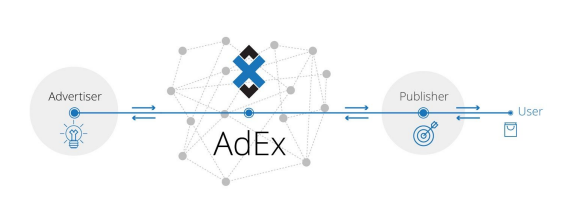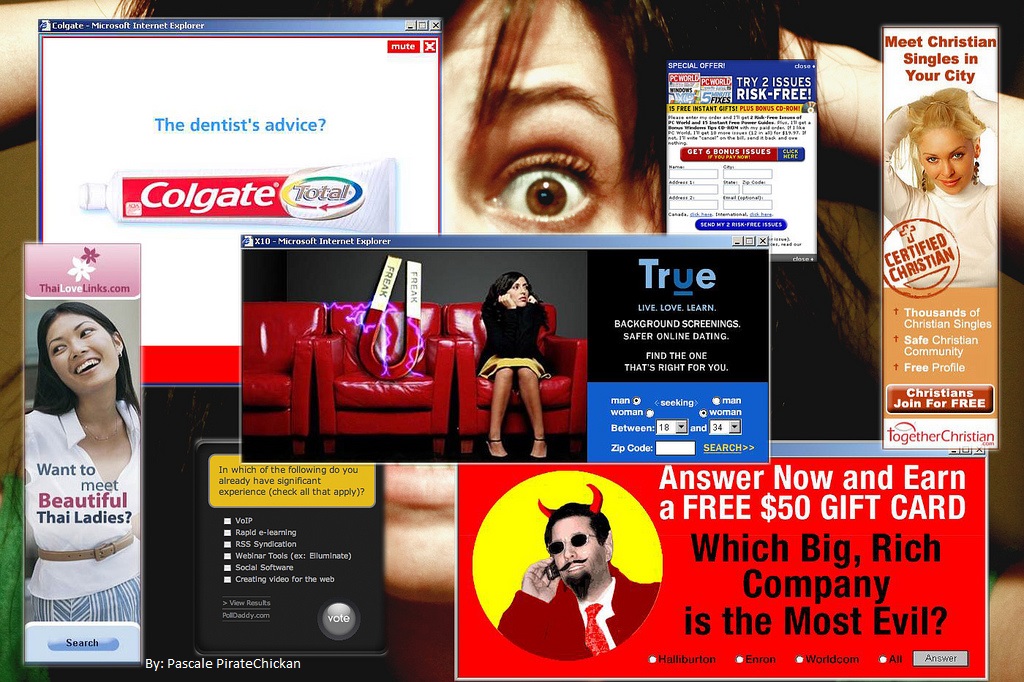
(Image Credit)
Instead of this:

(Image Credit)
Read on to better understand how the AdEx platform will change how consumers and ad curators interact with one another in a much more harmonious and beneficial ecosystem.
Funded by a crowdsource campaign launched in June of last year AdEx was created with the “aim to disrupt the existing online advertising landscape and address the significant problems it faces such as advertising fraud, privacy and consent to receiving sponsored messages, and the rise of ad blockers.” Not to mention the problem of legitimate advertisers who’ve spent time and money on these advertisements in vain.
On the outside, AdEx doesn't look revolutionary. As already mentioned Google and Facebook, the largest advertisers in existence DO give users a semblance of control over whether or not targeted ads are relevant, but is it a facade? Information about likes and dislikes, comings and goings, internet search habits and more are jumbled together to fit users into key categories which meet keywords created by retailers renting ad space. They also make an income from advertisers without guaranteeing their ads will be seen.
In the AdEx whitepaper they point out how just this practice creates a situation likely to expose the user and/or advertisers to human error were an ad labeled with an irrelevant keyword. If being exposed to unwarranted ads, or wasting money on ads that’ll never reach their destination doesn’t sound horrifying enough, Google and Facebook both sell users information to various agencies to use for whatever purpose they like despite what they may have told the original platform it was for.
*Gasp* AND THEN with their monopoly like power they unfairly ban ads that may be threatening to their own ecosystems-like those promoting crypto.
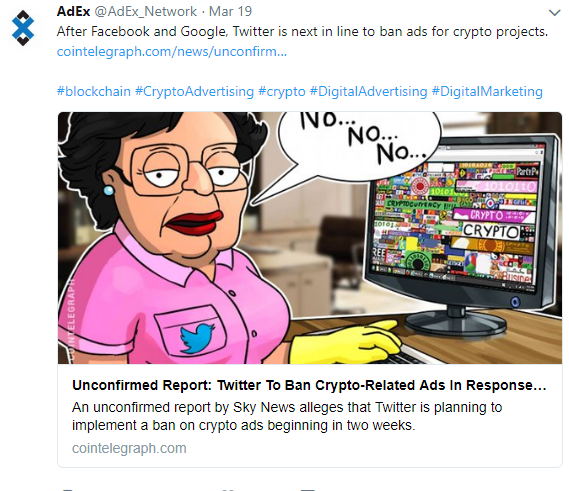
There’s no denying, data from customer metrics is extremely important to the success of advertisements and the products they support. Ads need to exist, and advertisers need direction in order to create them...but wouldn’t it be better if the data provided to companies was anonymous, ads were guaranteed to reach the user and users only received ads they elected to view? Would it be better if ads went straight from the advertiser to the publisher being consumed with no middle man to charge fees for facilitation? What if publishers were able to choose which ads appeared on their site pulling consumers back in who’d otherwise circumvent a site that might be known for malicious ads?
AdEx vows to accomplish this...negating the need for ad blocking technology on the consumer end, erasing middlemen and fake misleading ads from the matrix of advertisers with “impression and click verification” and anonymizing data provided to advertisement creators. This ecosystem is made up of a front end for consumers, a front end for advertisers and a control hub for publishers.
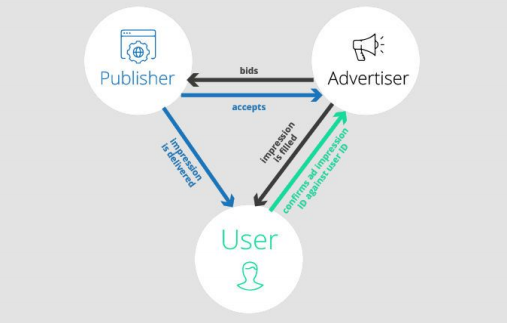
(Image Credit)
In the center is AdEx, originally an Ethereum based blockchain the system now resides on the NEO blockchain and collects information from consumer profiles, anonymizes it and places it on the ledger for advertisers to freely address and adhere to. When advertisers want to reach an audience, publishers negotiate with the ad company using smart contracts for a fee they’ll charge to display their ads. Publishers then adhere to the terms advertisers have laid out as to who their ads will reach. With a direct connection between publishers and advertisers like this ROI is maximized for both parties and a stronger relationship is forged with consumers.
Further to regulate ads and minimize unfair banning of what could be considered irrelevant, misleading or malicious ads, AdEx has implemented a voting system giving end-users complete control over what is considered wanted and unwanted within the ecosystem. This system encompasses not only a way to vote on the legitimacy and relevance of ads, but also of users.
With a current market-cap of $72,761,380 USD AdEx currently holds the rank of 189 and is available at Binance, Bittrex and Hit BTC among a number of other exchanges. With a total supply of 100,000,000 ADX, there are currently only 73,430,701 in circulation.
According to AdEx token distribution looks like this:
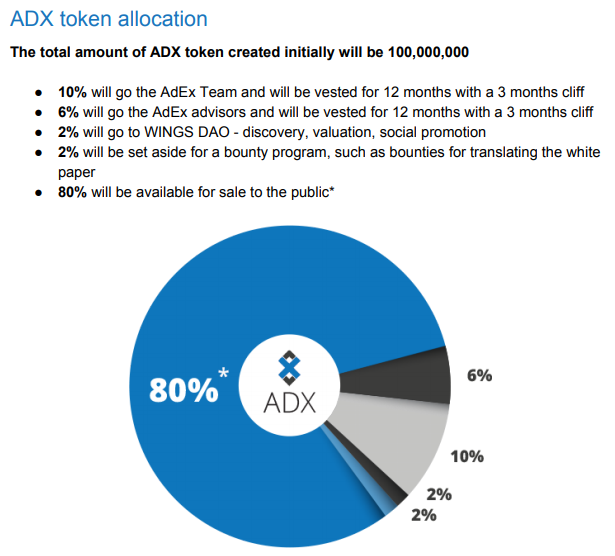
(Image Credit)
Partnering with Flixxo on April 20th this month, AdEx saw some serious volume increases for the 2 following days pushing the price up close to 200%. Busting through the .618 on my Fib and wicking all the way thru a stacked Fibonacci to the.382, price action bounced perfectly as it began to correct. Down to the .618, price action rallied a little bit and ultimately returned to where it was prior to their newest partnership.
Struggling to break the .618 again my hope is that price-action will climb over the new few weeks to a significant area of resistance above that .618 (indicated by the red arrow on my chart.) This of course is not advice or a certain path, it is as always only one idea of many which are likely.
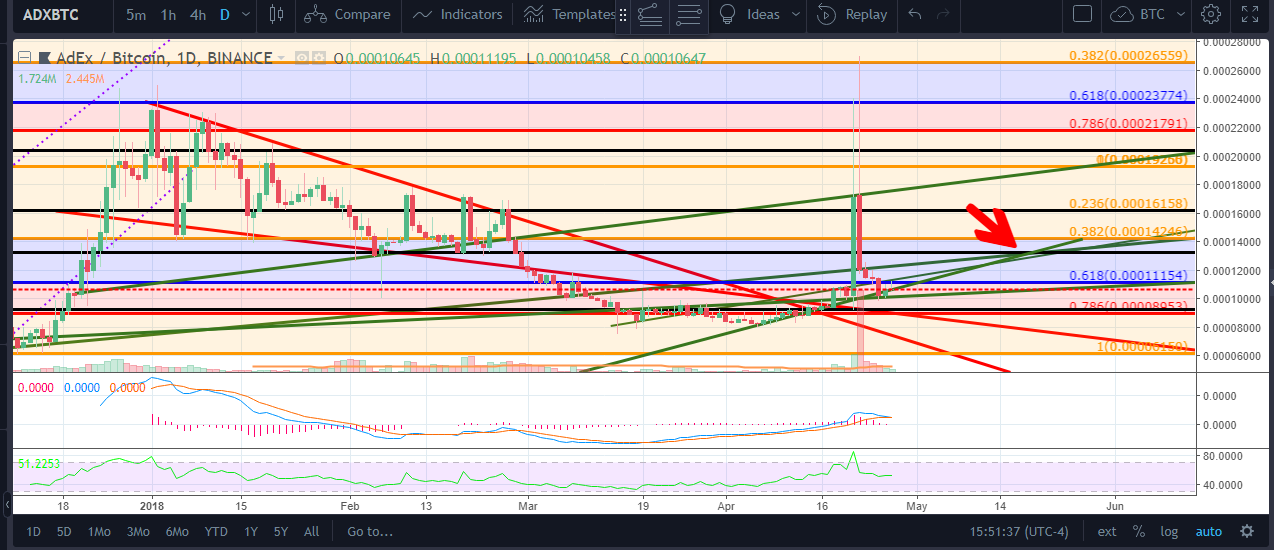
Follow this chart here.
With their protocol just getting ready to be released AdEx has a lot of big plans as indicated by their roadmap. Currently the team is working through scalability options, looking into Plasma as one option. Coming next are updates and improvements to how targeting and reporting are facilitated as well as changes to the publishers SDK.
What do you say, will you be taking the plunge and taking control over your experience? Do you believe this transparent system will better facilitate relationships between advertisers and publishers with overall growth and greater profitability? Is this a valid long-term solution for scalability and privacy?
Let us know in the comments!
°Br¡tT^N¥° (@TheJadeCrow on Twitter)
Coins mentioned in post:
Congratulations! This post has been upvoted from the communal account, @minnowsupport, by IDC2thaMoon from the Minnow Support Project. It's a witness project run by aggroed, ausbitbank, teamsteem, theprophet0, someguy123, neoxian, followbtcnews, and netuoso. The goal is to help Steemit grow by supporting Minnows. Please find us at the Peace, Abundance, and Liberty Network (PALnet) Discord Channel. It's a completely public and open space to all members of the Steemit community who voluntarily choose to be there.
If you would like to delegate to the Minnow Support Project you can do so by clicking on the following links: 50SP, 100SP, 250SP, 500SP, 1000SP, 5000SP.
Be sure to leave at least 50SP undelegated on your account.